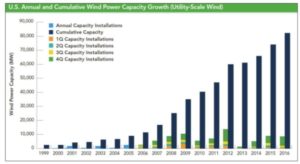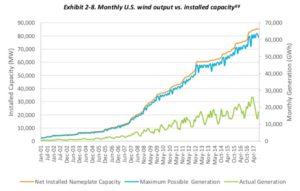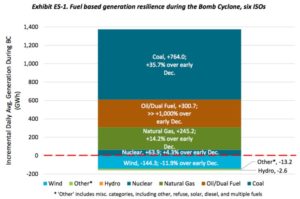The American Wind Energy Association (AWEA) is constantly bragging about increases in installed wind capacity.
AWEA has made statements such as the following from its 2016 annual report: ““Wind power delivered 30% of all new capacity installed over the past five years.” Accompanied by this chart:

Such claims, however, are very misleading. The real issues are: How much electricity can this installed capacity actually generate, and will it be available when it’s needed?
Claiming that 30% of all new capacity is from wind is very misleading because that capacity can’t generate very much electricity. This chart from the Department of Energy (DOE) shows how little electricity is generated by wind, despite its seemingly large installed capacity.
Source DOE: Green line wind generation, top line shows the installed nameplate capacity.
Even more important, the electricity may not be available when it’s needed. On very hot days, especially in the afternoon, the wind is prone not to blow. Yet this is when electricity is needed because of additional air-conditioning load. On cold winter days, the wind may blow either too hard, or not enough.
The recent winter storm in New England showed that wind couldn’t be relied upon. Wind output was down 12% from December’s output, during the period of the storm, as shown in this DOE chart. (Light blue area>)
Not only does the installed capacity generate very little electricity, which may not be available when needed, but it’s also very expensive compared to natural gas- or coal-fired power plants. According to the Institute for Energy Research (IER), the levelized cost of electricity (LCOE), a measure of total cost, from new power plants, using actual costs and capacity factors in 2015 were:
- Wind, 10.7 cents per kWh
- Natural gas, 5.5 cents per kWh
- Coal-fired (existing), 4.0 cents per kWh
Please note:
The LCOE for existing coal-fired power plants was referenced because it’s very difficult to obtain honest cost information. The EIA currently only publishes cost estimates for plants coming online in 2022 which are speculative, at best.
During the past several years, the EIA added an extra charge of $15 per ton of CO2 to its estimates for new coal-fired power plant LCOEs, distorting actual costs and making it impossible to use EIA data for cost comparisons.
If the cost of wind, and for that matter solar, were as low as being claimed by the media, the EIA, and others, wouldn’t have to distort their LCOEs, or manipulate them, such as providing estimates four years in the future or creating alternative measures such as LACE. See, Obfuscation
Summary
The amount of electricity actually produced from the huge investment in wind power is not only very small, it is unreliable and may not be available to meet peak power demand during hot (still) summer days. And during winter storms, wind power may fall off because the winds are too strong. So much for the notion that wind is there for the taking.
AWEA should be ashamed of itself for bragging about the increase in installed wind capacity and leaving the rest of the story untold. But in the crony world of wind energy, image and half-truths are everything.




Anyone wanting to find out what I= PAT is should read the following
“I-PAT Means Nothing, Proves Nothing” by Ben Courtice, Climate and Capitalism, March 17, 2018
LINK http://climateandcapitalism.com/2010/03/17/ipat-means-nothing-proves-nothing/
[…] Diverging Curves Display Wind’s LimitsThis chart from the Department of Energy (DOE) shows how little electricity is generated by wind, despite its seemingly large installed capacity. Image Source […]
You may find these references useful, re Weather Dependent Renewables in the USA and Europe
These figures make reasonable estimates of the costs of “Green Virtue Signalling”
I have recently found some updated 2017 costings from US EIA that changes my earlier cost model significantly.
Accordingly I have updated
https://edmhdotme.wordpress.com/a-dataset-of-eu-weather-dependent-renewable-energy-installations-output-costs-2008-2017/
And in the same vein I set up a parallel new post for the USA Weather Dependent Renewables
https://edmhdotme.wordpress.com/usa-weather-dependent-renewable-energy-to-2016-performance-and-costings/
The take home message is essentially the same
The numbers are just not quite as enormous and the USA Renewables are more efficient (a bit) than in Europe